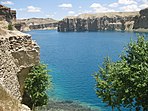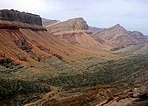
Back باميان Arabic Bamiyan (ciudá) AST Баміян (горад) Byelorussian Бамян (град) Bulgarian বামিয়ান উপত্যকা Bengali/Bangla Bamian Catalan Bāmyān (kapital sa lalawigan sa Nasod nga Afghano) CEB Bámján Czech Bamiyan Welsh Bamiyan Danish
Bamyan
بامیان Bamiyan | |
|---|---|
| Motto(s): بامیان بام دنیا "Bamyan, roof of the world" | |
| Coordinates: 34°49′30″N 67°50′00″E / 34.82500°N 67.83333°E | |
| Country | |
| Province | Bamyan |
| Settled | 2800 BCE[citation needed] |
| Government | |
| • President of City Council | Muhammad Tahir Zaheer |
| Area | |
| • Total | 35 km2 (14 sq mi) |
| Elevation | 2,550 m (8,370 ft) |
| Population (2014)[1] | |
| • Total | 70,000 |
| Time zone | UTC+4:30 |
| Postal code | 16XX |
Bamyan (Dari: بامیان), also spelled Bamiyan or Bamian, is the capital of Bamyan Province in central Afghanistan.[2][3][4][5] Its population of approximately 70,000 people makes it the largest city in Hazarajat.[1] Bamyan is at an altitude of about 8,366 feet (2,550 m) above sea level. The Bamyan Airport is located in the middle of the city. The driving distance between Bamyan and Kabul in the southeast is approximately 180 kilometres (110 mi). The Band-e-Amir National Park is to the west, about a half-hour drive from the city of Bamyan.
Bamyan is referred to by some as the "Shining Light" and "Valley of Gods".[6] There are several tourist attractions near the city, including the Buddhas of Bamyan, which were carved into cliffs on the north side of Bamyan city in the 6th and 7th century CE, dating them to the Hephthalite rule. Other attractions close to the city include Shahr-e Gholghola and Zuhak. In 2008, Bamyan was found to be the home of the world's oldest oil paintings.[7] At the end of the 10th century, there was a Buddhist culture in which several thousand Buddhist monks lived in caves carved into the mountain. The 53 meters known as the Salsal and 35 meters known as Shahmama are the high-standing Buddha statues and best-known monuments left by the Buddhists, which were destroyed by the Taliban in 2001.[8] Furthermore, there are several cultural sites left from both the Buddhist and the later Islamic era of the valley. After the overthrown of the Taliban from power in 2002, considerable efforts had been made to preserve the cultural monuments in the valley. The city of Bamyan has four districts and a total land area of 3,539 hectares.[9] The total number of dwellings in this city is 4,435.[9]
The Bamyan valley marked the most westerly point of Buddhist expansion and was a crucial hub of trade for much of the second millennium CE. It was a place where East met West and its archaeology reveals a blend of Greek, Turkic, Persian, Chinese, and Indian influences. The valley is one of Afghanistan's most touristic places.[10]
The city of Bamyan joined the UNESCO Creative Cities Network as a Crafts and Folk Art city in 2017.[11] "UNESCO noted the Bamiyan Valley is the most monumental expression of western Buddhism".[6] Bamiyan is now listed by UNESCO as a World Heritage Site in Danger.[12]
On 15 August 2021, Bamyan was seized again by Taliban fighters, becoming the twenty-ninth provincial capital to be captured by the Taliban as part of the wider 2021 Taliban offensive.
- ^ a b Cite error: The named reference
autowas invoked but never defined (see the help page). - ^ "Bamian". Lexico UK English Dictionary. Oxford University Press. Archived from the original on 31 December 2019.
- ^ "Bamian". Merriam-Webster.com Dictionary. Merriam-Webster.
- ^ e.g. Unesco Archived January 28, 2007, at the Wayback Machine, BBC
- ^ "About this Collection". The Library of Congress. Retrieved 26 April 2016.
- ^ a b "Information about Bamyan". Bamyan Foundation. Retrieved 19 April 2022.
- ^ "Top 10 Discoveries of 2008 - Oldest Oil Paintings - Bamiyan, Afghanistan - Archaeology Magazine Archive". archive.archaeology.org. 2009. Retrieved 29 January 2020.
- ^ "Why Bamyan province brings out the best of Afghanistan".
- ^ a b "The State of Afghan Cities report 2015". UN-Habitat. 2015. Archived from the original on 31 October 2015. Retrieved 22 October 2015.
- ^ Rasmussen, Sune Engel (19 September 2014). "An Afghan Town Known for Its Blown-Up Buddhas Wants to Be Your Next Holiday Destination". Slate Magazine.
- ^ "The Historic City of Bamiyan has joined the UNESCO Global Network of Learning Cities (GNLC) - Afghanistan National Commission for UNESCO". unesconatcom.af. Archived from the original on 3 October 2018. Retrieved 3 October 2018.
- ^ UNESCO World Heritage Centre. (2003b). Cultural Landscape and Archaeological Remains of the Bamiyan Valley. http://whc.unesco.org/en/list/208







